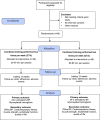Effects of combined training performed two or four times per week on 24-h blood pressure, glycosylated hemoglobin and other health-related outcomes in aging individuals with hypertension: Rationale and study protocol of a randomized clinical trial
- PMID: 34038410
- PMCID: PMC8153424
- DOI: 10.1371/journal.pone.0251654
Effects of combined training performed two or four times per week on 24-h blood pressure, glycosylated hemoglobin and other health-related outcomes in aging individuals with hypertension: Rationale and study protocol of a randomized clinical trial
Abstract
Background: Acute blood pressure lowering after exercise seems to predict the extent of blood pressure reduction after chronic exercise training interventions. Based on that, the same weekly amount of exercise performed more frequently could be more beneficial for controlling blood pressure.
Purpose: To compare the effects of a combined training program (resistance plus aerobic exercise) performed four or two times per week on 24-h ambulatory blood pressure and other health-related outcomes in middle-aged and older individuals with hypertension.
Methods: This study will be a randomized, parallel group, two-arm, superiority trial. Ninety-eight participants aged 50-80 years with a previous physician diagnosis of hypertension will be randomized to perform two or four sessions per week of combined training using the same total weekly overload. Primary outcomes will be 24-h ambulatory blood pressure and glycosylated hemoglobin; secondary outcomes will be endothelial function, physical fitness and quality of life. The outcomes will be assessed at baseline and at the end of 12 weeks period.
Results: Our conceptual hypothesis is that a combined exercise program performed four or two times per week with equalized weekly volume/overload will improve all outcomes in comparison to the baseline values, and that reductions in 24-h blood pressure and glycosylated hemoglobin will be more pronounced in the group that trained four times a week than twice. The results of this trial are expected to provide evidences to support that higher weekly frequency of combined training should be emphasized in aging adults with hypertension.
Conflict of interest statement
The authors have declared that no competing interests exist.
Figures
References
-
- Lewington S, Clarke R, Qizilbash N, Peto R, Collins R, Prospective Studies Collaboration. Age-specific relevance of usual blood pressure to vascular mortality: a meta-analysis of individual data for one million adults in 61 prospective studies. Lancet. 2002;360: 1903–1913. 10.1016/s0140-6736(02)11911-8 - DOI - PubMed
-
- Whelton Paul K., Carey Robert M., Aronow Wilbert S., Casey Donald E., Collins Karen J., Cheryl Dennison Himmelfarb, et al.. 2017 ACC/AHA/AAPA/ABC/ACPM/AGS/APhA/ASH/ASPC/NMA/PCNA Guideline for the Prevention, Detection, Evaluation, and Management of High Blood Pressure in Adults: Executive Summary: A Report of the American College of Cardiology/American Heart Association Task Force on Clinical Practice Guidelines. Hypertension. 2018;71: 1269–1324. 10.1161/HYP.0000000000000066 - DOI - PubMed
Publication types
MeSH terms
Substances
LinkOut - more resources
Full Text Sources
Other Literature Sources
Medical


